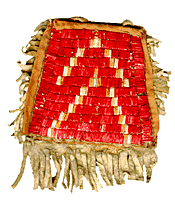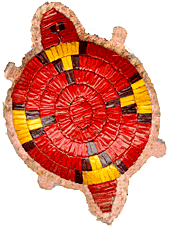
Porcupine quillwork significantly predates the use of glass beads. According to some sources, quillworking tools dating to the 6th century have been found on the plains. Because of the delicate nature of porcupine quills, most surviving examples are from the 19th and 20th centuries.
As recently as the 1970's, there was concern that porcupine quillwork was becoming a lost art. Few traditional artists were using the technique. However, with the recent interest in traditional Native American art and skyrocketing prices for antiquities, quillwork is on the rise. Today, you can buy prime examples of quillwork which rival the finest examples from the 19th century. An expertly made fully-quilled pipebag can easily demand $1,000 to $2,500 from a discerning collector.
There are many different methods of using porcupine quills to decorate objects. Here are examples of items decorated with some of the more common techniques:
Quilled Pipe Tamper
The object to the left is a quilled pipe tamper. It utilizes two quillwork techniques. The horsehair
dangles are a strip of leather decorated with quills using a quill wrapping technique. The lower portion is decorated
using quill plaiting. This particular tamper is sometimes referred to as a "puzzle tamper" because of the intricate
carvings. This object is made from one piece of wood and is 17 inches long. Lakota made c. 1994.

This small pouch measures
about 4 inches by 4 inches and is decorated with red-dyed porcupine quills which are sewn down in a method sometimes referred
to as straight quilling. Lakota c.1880-1900.

| Quilled Turtle Amulet A modern version
of an umbilical amulet. When a child was born, the umbilical cord was placed in an amulet. The amulet was often used by
the child as a toy and later saved for use as a charm in adulthood. Amulets were typically in shape of a turtle or lizard.
This amulet is an art object only and is decorated with dyed porcupine quills attached in the simple
straight quilling method. Lakota made c. 1996. |

| Quilled Pipebag Section
This is the quilled portion of a Plains pipebag. It is decorated using a simple quill wrapping technique around rawhide
slats. Lakota c.1880-1900 |

This is a close up view of a warshirt with porcupine quill wrapped hair locks. The red wrappings on the black hair is the
quillwork. Above the hairlocks is a small view of the beaded shirt strip.
We offer several books which teach you how to do porcupine quillwork and which illustrate numerous artifacts.
Copyright ©1997-2019 Matoska Trading Company